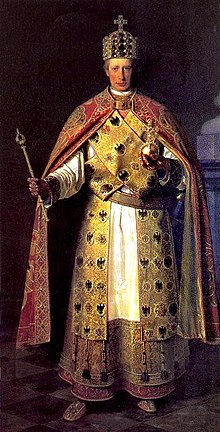Coronation regalia of the Roman-German emperors

The last Emperor of the Holy Roman Empire Franz II in the coronation regalia with the imperial insignia, painting by Ludwig Streitenfeld on behalf of Rudolf of Austria-Hungary , 1874
The coronation regalia of the Roman-German emperors consisted of the following parts since the Staufer period :
- Coronation mantle , set with over 100,000 pearls, gold embroidery, weighs 11 kg, Sicilian work, 1133/34
- Alba , Sicilian work from 1181, worn under the coat
- Dalmatica / Blue Tunicella , Sicilian work of the 12th century, worn under the Alba
- Eagle Dalmatica , probably never worn to a coronation
- Stole (2nd quarter of the 14th century)
- a pair of gloves set with pearls and precious stones (Sicilian work of the 13th century)
- a kind of knee socks with gaiters made of gold embroidered silk (Sicilian work of the 12th century)
- a pair of slippers set with pearls and precious stones (Sicilian work)
In addition, in a broader sense, the insignia used at the coronation (such as imperial crown, imperial orb, scepter and imperial sword) are counted as regalia .
The parts of the regalia were in use until the last imperial coronation in 1792. Today they are kept in the secular treasury in Vienna.
See also: Reichskleinodien
literature
- Hermann Fillitz : The insignia and jewels of the Holy Roman Empire. Schroll, Vienna et al. 1954.